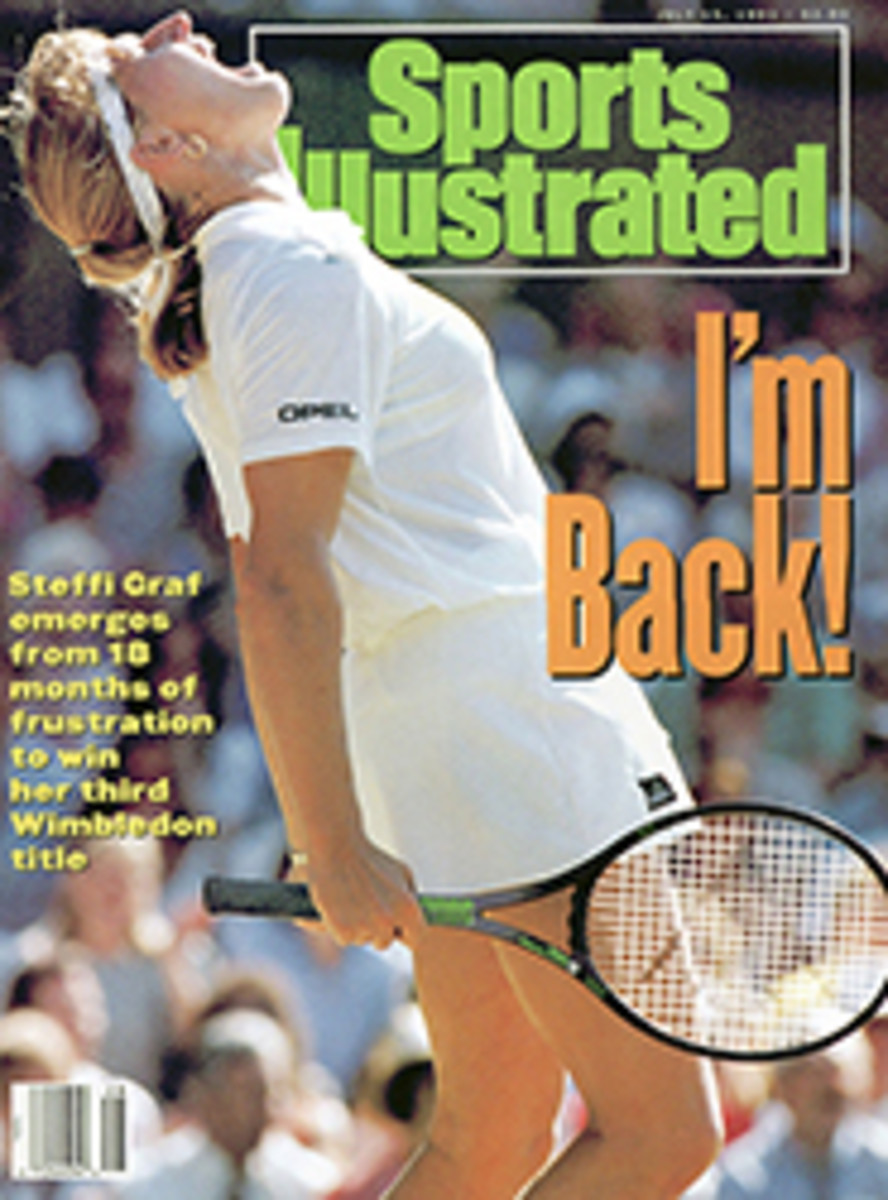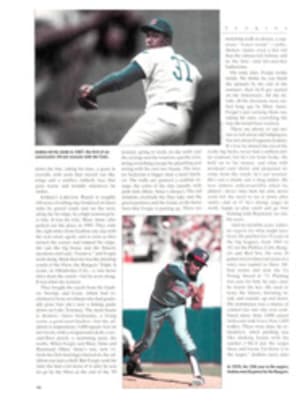
Baseball with a Finnish Spin
The pitcher faces the batter and prepares to deliver. Suddenly he whirls and fires the ball to first base—which is halfway up the third base line—despite the fact that there is no runner at first. However, there is a runner at second base, which is located where first base should be. The first baseman returns the ball to the pitcher, who then throws it to second. But the catcher, who is positioned halfway between home and second, intercepts the ball and pegs it back to the pitcher.
Finally, the pitcher, who is standing rather close to the plate, delivers the ball to the batter—by throwing it about 10 feet straight up. The runner on second takes off for third. The batter lofts a fly ball into the outfield, but he doesn't run. One of the two outfielders hauls it in and throws the ball to third. The runner from second beats the throw. He overruns the base, but nobody attempts to tag him. Nevertheless, the runner leaves the field. But he is not out.
The same batter is still hitting. On the next pitch he grounds a ball to the right shortstop (as opposed to the left shortstop), who scoops it up and returns it to the pitcher. The batter still has not left the plate. The pitcher delivers again. This time the pitch rises to a height of about 20 feet. The batter smacks the ball fair again, and now he takes off for first base. The pitcher waits for the ball to bounce, pounces on it and guns it to the first baseman. The batter is out.
No, this is not some capricious version of baseball dreamed up by the Queen of Hearts in Alice in Wonderland, nor is it baseball as seen by Samuel Beckett. This is pesäpallo, the national pastime of Finland. The previously described action took place last July in a pesäpallo game played during FinnFest USA '90, a four-day shindig at Suomi College on Michigan's Upper Peninsula.
For those accustomed to American baseball, the Finnish rendition takes some getting used to. "It's really hard to learn," said Kalereo (Kelly) Kemppainen, 46, who played for his Thunder Bay, Ont., team at the FinnFest. "If we have someone who wants to join our team, it takes him a whole season to learn this game. And even then he still doesn't know it all."
Pesäpallo was devised by professor Lauri Pihkala in the early 1920s after he had spent time studying in the U.S. The good professor found American baseball too slow for the Finnish temperament, and he set out to develop a game that would involve more players in more of the action, while also contributing to their physical conditioning. Combining elements of American baseball and various Finnish bat-and-ball games, he came up with a hybrid that emphasizes foot speed, endurance and strategy, and moves at a faster pace than the American pastime.
Today, pes‚Äö√†√∂¬¨√üpallo is a required part of the P.E. curriculum in Finnish schools, and there are more than 2,600 teams throughout the country. The sport is also played by Finnish èmigrès in Sweden, Norway, Australia, Japan and Canada. The hotbeds of Canadian Pes‚Äö√†√∂¬¨√üpallo are Vancouver and in southern Ontario along the Great Lakes. The FinnFest game pitted Thunder Bay against a combined team from Toronto and Sudbury.
To the uninitiated, pesäpallo is a bewildering affair. Whereas American baseball unfolds in an orderly fashion, and the open spaces and long pauses contribute to easy understanding, the Finnish game, played on a smaller field, is a kaleidoscopic montage of shifting defenses and scurrying base runners. The action is constant. "In this game, you don't have time to sleep in the dugout," said Kemppainen.
A pentagonal pes‚Äö√†√∂¬¨√üpallo field comes in four sizes—for men's, women's, adolescents' and children's play. The men's field is 308 feet long and 138 feet wide and has a base of hard-packed dirt—a surface similar to the base paths of a standard baseball diamond. While the overall field is smaller than, say, Yankee Stadium's, the zigzag arrangement of the bases and the increasingly greater distances between them (65, 111, 118 and 131 feet) make a trip around the base paths an endurance run of more than 420 feet. "In American baseball a runner on second is in scoring position," said Thunder Bay's Jari Leinonen. "Here, he still has a long way to go." In fact, for a kunnari, or home run, a batter needs only to reach third before the ball is relayed there.
The ball, slightly smaller and heavier than a baseball, is made of dense, hard India rubber with a fuzzy, tennis ball-like covering. The thin bat—either of wood or fiberglass—resembles a fungo bat and has a maximum length of 39 inches. All fielders wear the same kind of glove, a model similar to a first baseman's mitt, with a deep, wide webbing.
The basic rules of pes‚Äö√†√∂¬¨√üpallo are fairly comprehensible if you can get American baseball out of your mind. The pitch must rise more than three feet above the pitcher's head. If the batter swings at the descending ball and misses, it's a strike. It's also a strike if the batter doesn't swing and the ball hits the plate (a 19.5-inch-wide circle). If the ball misses the plate, it's a v‚Äö√†√∂¬¨√ü‚Äö√†√∂¬¨√ür‚Äö√†√∂¬¨√ü, or ball—literally, "crooked." When there's nobody on base, one ball constitutes a walk. The batter gets three strikes. After the third strike, he must run. If the pitcher's throw beats him to first, the batter is kuollut, out, or—literally—"killed."
The batter is allowed three swings whether they're strikes or not, but he isn't required to run on the first two, even if he hits the ball and it lands fair. A foul ball on the third strike is an out.
If a batter runs on a fly ball that is caught and he reaches first before the ball is thrown there, he's not out—he's haava, or "wounded." Likewise, when a base runner is going on the pitch and the batted ball is caught on a fly, the runner is out only if the throw beats him to the next base. If he beats the ball, he's merely wounded. When a throw beats a runner to a base, no tag is required, and runners can overrun all bases. When a player is wounded, he leaves the field. A side is retired after three kills or nine woundeds.
The key to offense in Finnish baseball is advancing the runners. Since the batter is required to run only on the third swing, he will often drop a bunt or slap a ball on the ground on his first swing in order to move the runners up. If the batter thinks he can make it to first, he may elect to run. Otherwise he'll stay put and take another shot at getting a clean base hit. With two strikes he might deliberately hit a catchable fly ball, which results in his only being wounded, rather than risk hitting a ball on which he can be put out at first.
The FinnFest game, which drew 1,200 spectators, was played on a field laid out especially for the occasion. By the end of the second inning—thanks to Leinonen's expert play-by-play commentary on the P.A. system—the largely novice crowd began to have some idea of which end was up. "Compared to this, regular baseball is like watching grass grow," said one of the newly converted fans.
Unaccustomed to the somewhat unpredictable bounces off the grass surface, the fielders misplayed several balls, and both teams scored often. In the top of the third, with Toronto-Sudbury ahead 11-7, Thunder Bay tallied twice and had runners on second and third when a Toronto-Sudbury outfielder intentionally dropped a fly ball to load the bases and set up a force play all around. With the runners going, the next batter popped up to the outfield. That left everybody wounded, and it thus cleared the bases. No more runs scored, and in the bottom of the inning Toronto-Sudbury's cleanup hitter, Pasi Teini, belted his second kunnari of the game. Despite a furious charge by Thunder Bay in the top of the ninth, Toronto-Sudbury held on to win 17-15. At this point one of the players on the victorious team broke out a large ice chest and passed around beers to all competitors. Here, finally, was an aspect of Pesäpallo that everyone present could comprehend without lengthy explanation.
PHOTO
JOHN BIEVER
Who's on first? A more reasonable question at the FinnFest pentangle was, Where is first?
PHOTO
JOHN BIEVER
As the pitcher wound up, the batter prepared to swing but not to run.
PHOTO
JOHN BIEVER
The glove resembled a first baseman's mitt crossed with a goalie's.
Jay Feldman, a frequent contributor to SI, took up Finnball last summer.

